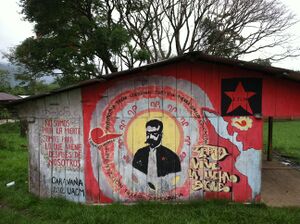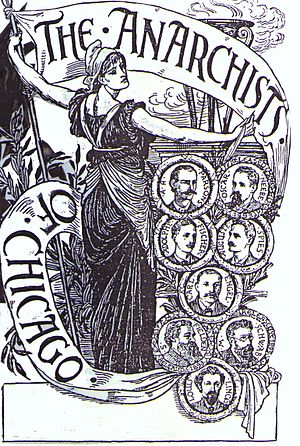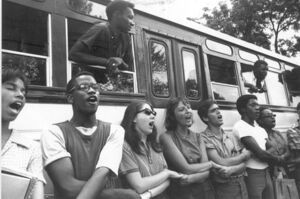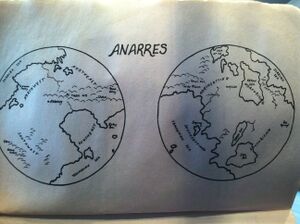Main Page: Difference between revisions
| Line 1,024: | Line 1,024: | ||
==Anarchist== | ==Anarchist== | ||
[[File:Anarres.jpeg|thumbnail]] | [[File:Anarres.jpeg|thumbnail|[[Anarres]]]] | ||
[[Anarres]] (''The Dispossessed'') | [[Anarres]] (''The Dispossessed'') | ||
Revision as of 17:04, 28 May 2015
Welcome to AnarchyinAction.org!
A work-in-progress, AnarchyinAction.org will be a resource for anyone to research and write about how and when anarchy can work. Anarchy, coming from the Greek words an (without) and archos (ruler) refers to a situation without domination, without coercive hierarchy. We have collected hundreds of examples of anarchy in practice, many of them from the following works:
An Anarchist FAQ (excerpt)
Anarchy in Action by Colin Ward
Anarchy Works by Peter Gelderloos
Cartography of Revolutionary Anarchism by Michael Schmidt
Mutual Aid: A Factor of Evolution by Peter Kropotkin
People Without Government: An Anthropology of Anarchy by Harold Barclay
The Politics of Social Ecology: Libertarian Municipalism by Janet Biehl with Murray Bookchin (excerpt)
We sort the examples by their scale and focus. The list of societies encompasses confederations of residential communities. The list of communities includes communes, towns and neighborhoods small enough for people to make face-to-face decisions. The movements and uprisings category includes large-scale movements, rebellions, campaigns and mobilizations. The organizations category includes groups and their federations. Everyday anarchy lists anarchic projects and phenomena that exist all around us even in capitalist societies. Playfully but still seriously, we add two further categories. In a nod to the naturalist Peter Kropotkin who saw cooperative activity as a factor of evolution, we add nonhuman anarchy to explore power relations in nonhuman animal and ecological communities. Lastly, we add the category of fictional anarchy, which includes, for example, the planet Anarres from Ursula K. LeGuin's novel The Dispossessed.

We also sort these examples into four main organizational categories. Anarchism refers to a political theory and practice that arose in the 19th century, aimed at abolishing coercive hierarchy and establishing a libertarian socialist society in its place. Anti-authoritarianism refers to a broader category of politics including groups such as the Wobblies and Zapatistas that do not necessarily call themselves anarchists but oppose coercive hierarchy and attempt to eliminate it. Third, a participatory category includes examples such as ancient Athens where anarchy is extended to many but not to all or even necessarily to most of society. Participatory politics encompasses anti-authoritarianism, which encompasses anarchism. Finally, the autonomous category refers to self-governed communities that shift power relations in an anti-authoritarian direction, such as the Paris Commune, which fell short of participatory governance. By looking for anarchy beyond self-identified anarchist projects, we aim to respond to Maia Ramnath's call in Decolonizing Anarchism to locate anarchism "as one contextually specific manifestation among a larger-indeed global-tradition of antiauthoritarian, egalitarian thought/praxis".[1]
In our articles, we try to explore how horizontal societies and communities deal with culture, decisions, economy, environment, crime, revolution, and neighboring societies. We do not claim or attempt to present evidence that anarchy is possible in all situations. Nor do we deny humans' innate potential for hierarchy and indeed for extreme cruelty. We present this resource for curious and open-minded people to collaboratively explore the question of whether a horizontally-run world is possible and what this world might look like.
AnarchyinAction.org is a project of Capitalism vs. the Climate and of our friends at Get Libre, the Wesleyan University Infoshop, and elsewhere. If you would like to get involved, please email dfischer@riseup.net.
For resources on writing and editing this wiki, please see our Editing Guide.
Societies
"Living without a state remains not a socio-historical anomaly but the standard human condition." -Andrej Grubačić[2]
"The instant formal government is abolished, society begins to act: a general association takes place, and common interest produces common security." -Thomas Paine[3]
Anarchist

Revolutionary Spain, 1936-9, 3.2 million people
Revolutionary Ukraine, 1918-1921, 7 million people
Shinmin Prefecture, 1929-1931, 2 million people

Anti-Authoritarian


El Alto, 1 million people
Catal Huyuk, 7500 to 5700 BCE, 6,000-10,000 people
Kurdistan democratic confederalists, present, 4.6 million in Rojava
Mapuche, 1 million people in sixteenth century
Zapatista-run Chiapas, 1994-present, 120,000-300,000 people
Zomia, present, 100 million people
Participatory

Athenian polis, 594-431, 404-403 BCE, 40,000 male citizens
Kibbutzim, 1919-present, 120,000 members
Autonomous
Paris Commune, 1871, 2 million people
Unsorted
Land Dayaks
La Paz Zapotec, nearly 2,000 people
Maori
New Guinea indigenous peoples
Northwest coast indigenous peoples
Nubian people
Nuer
Imazighen
Ifugao
Dinka people
Communities
"The Europeans also imposed their own legal, administrative and security systems in order to meet the needs of the new monetized economies and the more active modern states. All this meant a painful disruption of the familiar communalism of the past. Land now became a mere possession, food a mere commodity of exchange, neighbor a mere common property owner and labor a mere means of survival."-L.S. Stavrianos[4]
"The current theory as regards the village community is, that in Western Europe it has died out by a natural death, because the communal possession of the soil was found inconsistent with the modern requirements of agriculture. But the truth is that nowhere did the village community disappear of its own accord; everywhere, on the contrary, it took the ruling classes several centuries of persistent but not always successful efforts to abolish it and to confiscate the communal lands."-Peter Kropotkin[5]
Anarchist
Guangzhou commune, 1921-1923
Anti-Autoritarian



Christiania, 1971-present, 900 people
Faslane Peace Camp, 1982-present
Free Republic of Wendland, 1980, 5,000 people
George's Hill (Diggers), 1649, 40 people
Greenham Common Women's Peace Camp, 1981-200
Life and Labor Commune, 1921-1930, nearly 1,000 people
Village Alternatif, Anticapitalist et AntiGuerres, 2003, thousands of people
Participatory
Autonomous
Kuzbass Autonomous Industrial Commune, 1922-1926
Unsorted
Alcatraz occupation
Taita Hills
Ghana shantytown
Minnehaha Free State
Mexican colonial proletarias
Peruvian 'barriadas
Tunisian gourbivilles
Indian bus tees
Turkish gecekondu
Venezuelan ranchos
Movements and Uprisings
"If we had surrendered, if we had sold ourselves, we would no longer have been poor, but others would have continued to be so." -Subcomandante Marcos[6]
"People have done horizontal, or non-hierarchical, organization all their lives. It is already there in my culture and the way Palestinian activism has worked. During the First Intifada, for instance, when someone's home was demolished, people would organize to rebuild it, almost spontaneously. As a Palestinian anarchist I look forward to going back to the roots of the First Intifada. It did not come from a political decision. It came against the will of the PLO." -Beesan Ramadan[7]
Anarchist

Building the Syndicalist Unions
Anarchists in the Russian Revolution
Anarchists in the Italian Factory Occupations
Anarchism and the Spanish Revolution
Anarchism in the Cuban Revolution
Modern schools
Anti-Authoritarian
Cascadia Free State, 1995-6
Grassroots Hurricane Katrina relief
Stop Huntingdon Animal Cruelty
The May-June Revolt in France, 1968
Zone to Defend (ZAD), 2012-present
Participatory
Autonomous

2007 Lakota declaration of independence
Anarchy in the American Revolution
Unsorted
1903 Macedonian revolt
1905–1907 Russian Revolt
1910 Mexican revolution
1960 student revolts
Parisian urban gardeners
Cantonalist Revolt of 1873-1874
Mohawk road blockade, 1990
Work democracy
Organizations
"SNCC without knowing about anarchism as philosophy embodied the characteristics of anarchism." -Howard Zinn[8]
"The real question at issue is not organization versus non-organization, but rather, what kind of organization. What different kinds of anarchist organizations have in common is that they are developed organically from below, not engineered into existence from above." -Murray Bookchin[9]
Most of the membership numbers come from Michael Schmidt's Cartography of Revolutionary Anarchism and refer to peak rather than current membership.
Anarchist

Teahouse Labour Union, 11,000 members in 1918
National Confederation of Labor (CNT), 2 million members in 1936
International Workers' Association (IWA)
Iberian Anarchist Federation (FAI)
Spanish Regional Federation (FRE), 60,000 members in 1873
Chilean Labourers Federation (FTCh), 60,000 members in 1921
Revolutionary Insurgent Army of the Ukraine (RPAU), 110,000 members
All-Russian Confederation of Anarcho-Syndicalists (ARKAS), 88,000 members
Italian Anarchist Union (UAI), 20,000 members
General Confederation of Labor (CGT) (Spain), 60,000 members in 2010s
National Confederation of Labor--France (CNT-F)
Swedish Central Workers' Organisation (SAC), 10,000 members in 1990s
Argentine Regional Workers' Federation of the 5th Congress (FORA-V), 200,000 members in 1919
House of the World Worker (COM), 50,000 members in 1910s
Bleikhman's Petrograd Anarchist Communist Federation (PACF)
Union of Anarcho-Syndicalist Propaganda (MFAG)
Moscow Federation of Anarchist Groups
Black Guards, 1,000 members
Federation of Anarchist-Communists of Bulgaria (FAKB)
Autonomous Action (AD)
Confederation of Anarcho-Syndicalists (KAS)
Confederation of Revolutionary Anarcho-Syndicalists (KRAS)
Revolutionary Confederation of Anarcho-Syndicalists, Nestor Makhno (RKAS-NM), 2,000 members
Indigenous Popular Council of Oaxaca--Ricardo Flores Magnón (CIPO-RFM)
Magónista-Zapatista Alliance (AMZ)
Anarchist Workers' and Students' Group (ASWG)
Awareness League (AL)
Anarchist Resistance Movement (ARM)
Durban Anarchist Federation (DAF)
Zabala Anarchist Communist Front (ZACF)
North-Eastern Federation of Anarcho-Communists (NEFAC)
Common Struggle Libertarian Communist Federation
Common Cause
Libertarian Communist Union
Siberian Confederation of Labor (SKT)
Anarkismo.net
Workers' Solidarity Movement (WSM)
Libertarian Socialist Movement (LSM)
Libertarian Alternative (AL)
International Brotherhood
International Alliance of Socialist Democracy
Anarchist organizations within the International Working Person's Association
Anti-Authoritarian International
Anarchist Federation of the Altai (AFA)
Anarchist Federation of Poland (AFP)
Revolutionary Anarchist Socialist Party (PSAR)
German Anarchist Federation (AFD)
East Asian Anarchist Federation (EAAF)
Anarchist International Relations Commission (CRIA)
Continental Commission of Anarchist Relations (CCRA)
Korean Anarchist Federation's Chinese Exile Section (KAF-C)
Korean Anarchist Federation (KAF)
Korean Anarchist Communist Federation (KACF)
Korean Anarchist Federation in Manchuria (KAF-M)
Durruti Column
Friends of Durruti (AD)
Kronstadt Accords (ZK)
Francophile Anarchist Federation (FAF)
Italian Anarchist Communists (FdCAI)
Anarchist Federation of Britain (AFB)
Japanese Anarchist Federation (JAF)
Spanish Regional Anarchist Organisation (OARE)
Anarchist Communist Alliance
Anarchist Federation
Black Front Society
Libertarian Socialist Council (LSC)
Workers' Solidarity Movement (RRU)
Workers' Solidarity (RR)
Co-ordination of Anarchist Groups
Anarcho-Communist Port-workers' Group (ACAOP)
Anarcho-Syndicalist National Confederation of Labour (ASNKR)
Union of Communist Anarchists (UCAI)
Federation of Communist Anarchists of German (FKAD)
Federation of Anarchist-communist Groups of Poland and Lithuania (FAGPL)
Japanese Anarchist Club (JAC)
Anarchist Federation
Federation of Anarchist Groups of Cuba (FGAC)
Anarchist Black Cross (ABC)
International of Anarchist Federations (IAF)
Iberian Anarchist Federation (FAI)
anarchist faction in Movement of the Revolutionary Left (MIR)
Anarcho-Communist Unification (CUAC)
Libertarian Communist Organisation (OLC)
Uruguayan Anarchist Federation (FAU)
Anarchist Revolutionary Organisation (ORA)
Proletarian Action Anarchists Groups (GAAP)
Italian Anarchist Federation (FAI)
Federation of Communist Anarchists (FdCA)
Polish Anarchist Federation (FA)
Communist League of Anarchists
Anarcho-Syndicalist Federation
Anarchist Federation (AF) / Czech and Slovak Anarchist Federation (CSAF)
Federation of Libertarian Socialists (FFS)
General Delegation of the CNT (CNT-DG)
Venezuelan Regional Workers' Federation (FORV)
Federation of Anarchist Groups of Cuba (FGAC)
Cuban Libertarian Alliance (ALC)
General Confederation of Labor (CGT)
Federation of Anarchist Groups in Cuba (FGAC)
Yunan guerilla campaigns
Bolivian Regional Workers' Confederation (CORB)
Feminine Workers' Federation (FOB)
Revolutionary Popular Organisation 33 (OPR-33)
Libertarian Resistance (RL)
Workers' Liberation Group (Shagila)
The Scream of the People (CHK)
Movement 2 June (M2J)
Angry Brigade (AB)
Direct Action (AD)
Anti-capitalist Autonomous Commandos (KAA)
Left Opposition (LO)
Wiyathi Collective within the Anti-Capitalist Convergence
Anti-Authoritarian




Industrial Workers of the World (IWW)
Industrial Workers of the World- Chile (IWW-Chile), 25,000 members in 1920
Cuban National Labour Confederation (CNOC), 200,000 members
Libertarian Socialist Institute
Student Nonviolent Coordinating Committee
IWW-Sierra Leonne, 3,240 members
Solidarity Union Democracy (SUD)
European Federation of Alternative Syndicalism (FESAL-E)
General Confederation of Labour (CGT), 230,000 members in 1906
Industrial Union of North and South America (UIANS) (Mexico)
Liberation Army of the South (ELS) (Mexico), 70,000 members
Industrial Syndicalist Education League (ISEL), 150,000 members in 1910s
Irish Transport & General Workers' Union (ITGWU), 12,000 members in 1917
Situationist International
Siberian Industrial Workers of the World (IWW-Siberia), 16,000 members
General Workers' Federation (GFP), 40,000 members
Union of Trade Unions (ZZZ)
Polish Syndicalist Union (ZSP)
Italian Syndicalist Union (USI)
Free Association of German Trade Unions (FvDG), 100,000 members
German Workers' Union of Germany (AAUD), 30,000 members
General Labour Union--Unity Organisation (AAU-E), 75,000 members
American Continental Workingmen's Association (ACAT)
General League of Koreans (HCH)
Libertarian Youth Federation of Iberia (FIJL)
Libertarian Youth (JJLL)
International Revolutionary Syndicalist Federation (FISR)
Syndicalist Workers' Federation (SWF)
Federation of Free Labour Unions (FFLU)
Independent League of Trade Unions (OVB)
IWW Marine Transport Workers' Industrial Union (MTWIU)
Chilean IWW
Ship-building Workers' Federation (FTB)
1951 syndicalist resistance in New Zealand
Industrial and Commercial Union of Southern Rhodesia (ICU yase Rhodesia)
National Convention of Workers (CNT), 400,000 members in 1972
Autonomous Workers' League (AWL)
Autonomous Village Movement (AVM)
Aid Group for the Libertarians and Independent Syndicalists in Cuba (GALSIC)
Participatory
Autonomous
Unsorted
Albany Free School
Quechua Farmers School
Universidad Transhumante
Free Stores
Freecycle Network
Critical Resistance
Take Back the Night
Philly's Pissed
No Border Network
Spanish Regional Labour Federation (FTRE)
Pact of Union & Solidarity (PUS)
Spanish Regional Workers' Federation (FORE)
Proletarian Circle (CP)
Grand Circle of Mexican Workers (GCO)
Regional Federation of the Eastern Republic of Uruguay (FRROU)
Worker's Federation (FO)
Artisan's Central Council (JCA)
Labourer's Circle (CT)
Cuban Labour Confederation (CTC)
Central Labor Union (CLU)
Northern Worker's Union (NWU)
Federation of Labour Exchanges (FBT)
1907 International Anarchist Congress
1913 Syndicalist Conference in London
Insurgent Committee of Revolutionary Partisans
National Labour Secretariat (NAS), 18,700 members in 1895
Federation of Freedom-loving Communists (FVC)
Libertarian Communist Organization
Libertarian Alternative
Committee for the Defence of Revolutionary Syndicalism (CDSR), 100,000 members
Trans-Siberian Railway
Industrial Workers of the World-US (IWW-US)
Confederation of Labour Associations (GLH)
Hunan Workers' Association
Black Societies
Wonsan General Trade Union
Free Trade Union
Argentine Regional Workers' Federation (FORA)
Argentine Regional Workers' Confederation (CORA)
Argentine Regional Workers' Federation of the 9th Congress (FORA-IX)
Argentine Libertarian Alliance (ALA)
Resistance Society of the Port-workers of the Capital (SROPC)
Uruguay Regional Workers' Organisation (FORU)
Brazilian Labour Confederation (COB)
Paraguayan Regional Workers' Organisation (FORPa)
Paraguayan Regional Workers' Centre (CORP)
National Revolutionary Alliance (ANR)
Workers' Trade Union Reorganisation Council (CORS)
Havana Labour Federation (FOH)
Cuban Workers' Confederation (CTC)
Chilean Workers' Central (CUT)
Mexican Regional Workers' Organization (FORM), 150,000 members in 1921
General Confederation of Labour (CGT)
Peruvian Regional Workers' Federation (FORPe)
Local Workers' Federation of Lima (FOL)
Colombian Workers' Federation (FOC)
Local Workers' Federation (FOL)
Feminine Workers' Federation
Guayas Workers' Regional Federation (FORG)
Ecuadoran Regional Federation of Labor (FTRE)
National Workers' Union (UON)
General Confederation of Labour (CGT)(Spain), 90,000 members in 1919
National Workers' Union (UON)
General Confederation of Labour (CGT) (Portugal)
Mexican Industrial Workers of the World (IWW-Mexico)
Mexican Liberal Party (PLM)
Industrial Union of North and South America (UIANS)
Liberation Army of the South (ELS)
National Agrarian Party (PNA)
Vlassovden Confederation
Italian Workers' Party (POI)
Free Workers' Union of Germany (FAUD), 120,000 members
North African Libertarian Movement (MLNA)
Korean Youth Federation in South China (KYFSC)
Federation of Free Society Builders (FFSB)
Korean Revolutionary Federation (KRF)
National Confederation of Labour (CNT)
General Italian Workers' Federation (CGIL)
Conference of Labour Unions (CLU)
Federation of Libertarian Socialists (FFS)
Independent League of Trade Unions (OVB)
General Confederation of Labor (CGT) (Cuba)
North African Libertarian Movement (MLNA)
Libertarian Communist International (ICL)
Libertarian Communist Organisation (OCL)
Libertarian Alternative (AL)
Second Escambray Front
Student Revolutionary Directorate (DRE)
Cuban Confederation (CTC)
Anarchists within the 26th of July Movement
Cuban Libertarian Movement in Exile
Swedish Workers' Central Organisation (SAC)
General Confederation of Labour (CGT) (Chile)
National Workers' Unity Movement (MUNT)
Federation of the Provincial Proletariat (Shengwulian)
Worker-Student Resistance (ROE)
Union of Libertarian Communist Workers (UTCL)
Alternative Libertaire
Interior Defense (DI)
First of May Group (GPM)
Iberian Liberation Movement (MIL-GAC)
Groups of International Revolutionary Action (GARI)
Neutralist Tribune
Movement of Revolutionary Communards (MRC)
Free General Workers' Union (SMOT)
Federation of South African Trade Unions (FOSATU)
Black Front Society (KSS)
Everyday Anarchy
"If there’s a line to get on a crowded bus, do you wait your turn and refrain from elbowing your way past others even in the absence of police? If you answered 'yes', then you are used to acting like an anarchist!" -David Graeber[10]

Anarchist
Anti-Authoritarian
Participatory
Autonomous
Stonehenge Free Festival, 1972-1985 (one month a year), 30,000 people
Woodstock Festival, 1969, 40,000 people
Vienna Psychoanalytic Society's child guidance service
Horizontal organization in British architecture
Unsorted
Mexican colonial proletarias
Peruvian 'barriadas
Tunisian gourbivilles
Indian bus tees
Turkish gecekondu
Venezuelan ranchos
Prestolee School
Institueion Libre de Enseiianza
Residential College for Students
1960 student revolts
Freetown playground
Skrammellegeplad playgrounds
Robinson Crusoe playgrounds
Brixham fishing cooperative
Brora mining cooperative
Standard tractor factory
Durham worker-managed mines
Gheel mental health care
Synanon
Claimant's Union
Eyes on the street
Nonhuman Anarchy
"The forest has always been my teacher in peace, in diversity in democracy. Diverse life forms, small and large, moving and immobile, above ground and below, with wings, feet or leaves, find their place in the forest. The forest teaches us that in diversity lie the conditions of peace, the realization of democracy." -Vandana Shiva[11]
"Indeed, anarchism can be illustrated with the example of ecosystems. Both are composed of separate but interdependent living organisms that evolve in endless variations to meet their needs." - scott crow[12]
Fictional Anarchy
"We live in capitalism, its power seems inescapable – but then, so did the divine right of kings. Any human power can be resisted and changed by human beings." -Ursula K. LeGuin[13]
Anarchist
Anarres (The Dispossessed)
Mars (Mars trilogy)
San Fransisco (The Fifth Sacred Thing)
Anti-Authoritarian
Nowhere (News from Nowhere)
Participatory
Umuofia (Things Fall Apart)
Autonomous
Unsorted
Examples by Source
- ↑ Maia Ramnath, Decolonizing Anarchism: An Antiauthoritarian History of India's Liberation Struggle (AK Press, 2011), 6.
- ↑ Andrej Grubacic, "Exit and Territory" in Alexander Reid Ross, Grabbing Back: Essays Against the Global Land Grab (Oakland, AK Press, 2014), 160.
- ↑ Thomas Paine, Rights of Man, 1791 https://ebooks.adelaide.edu.au/p/paine/thomas/p147r/chapter4.html.
- ↑ L.S. Stavrianos, Global Rift: The Third World Comes of Age (New York: William Morrow and Company, 1981), 270.
- ↑ Mutual Aid: A Factor of Evolution
- ↑ Subcomandante Marcos, "Why We Chose the Weapon of Resistance" in Our Word is Our Weapon (New York: Seven Stories Press, 2001), 160.
- ↑ Joshua Stephens, “Palestinian Anarchists in Conversation: Recalibrating anarchism in a colonized country,” Institute for Anarchist Studies, 19 July 2013, http://anarchiststudies.org/2013/07/19/palestinian-anarchists-in-conversation-recalibrating-anarchism-in-a-colonized-country/.
- ↑ Howard Zinn, "Anarchism Shouldn't Be a Dirty Word," AlterNet, 16 May, 2008, http://www.alternet.org/story/85427/howard_zinn%3A_anarchism_shouldn't_be_a_dirty_word.
- ↑ Murray Bookchin, "Anarchy and Organization", Libcom.org, http://libcom.org/library/anarchy-organization-murray-bookchin.
- ↑ David Graeber, "Are You an Anarchist? The Answer May Surprise You!", The Anarchist Library, http://theanarchistlibrary.org/library/david-graeber-are-you-an-anarchist-the-answer-may-surprise-you.
- ↑ Vandana Shiva, "Foreword" in Derrick Jensen and George Draffan, Strangely Like War: The Global Assault on Forests (White River Junction: Chelsea Green Publishing Company, 2003), vii.
- ↑ scott crow, Black Flags and Windmills: Hope, Anarchy, and the Common Ground Collective (Oakland: PM Press, 2011), 72.
- ↑ "Ursula K Le Guin's speech at National Book Awards", The Guardian, 20 November 2014, http://www.theguardian.com/books/2014/nov/20/ursula-k-le-guin-national-book-awards-speech.













